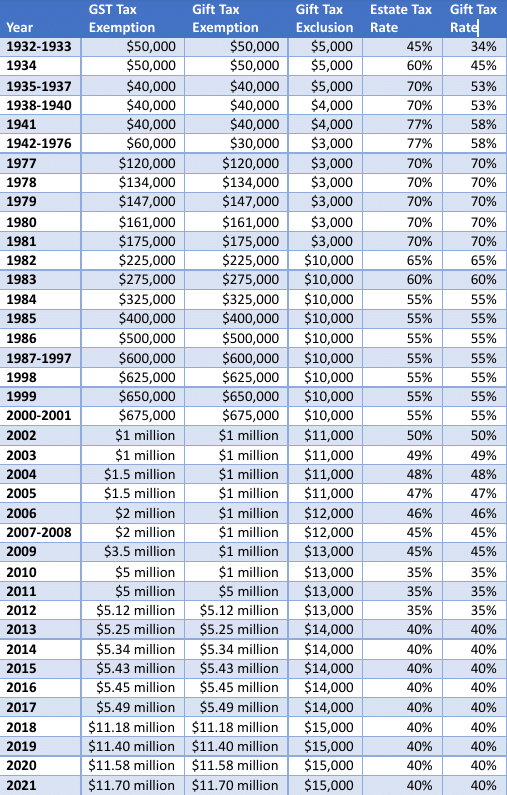
A 529 plan may be an efficient property planning device. However as a result of many households are unaware of its advantages, only a few think about using a 529 plan for property planning.
Nonetheless, households may have to think about together with 529 plans as a part of their property plans due to potential modifications to dying taxes.
We clarify why in additional element under and break down all of the “how-tos” of utilizing a 529 plan for property planning. Here is what that you must know.
Potential Adjustments To Loss of life Taxes
In 2024, the unified lifetime present, property and generation-skipping switch tax exemption is $13.6 million ($27.2 million for married {couples}), up from $5.49 million in 2017.
Since 2010, the lifetime exemption has been transportable between spouses, permitting a surviving partner to get the unused portion of their partner’s lifetime exemption. This successfully offers a married couple with twice the lifetime exemption of a single individual. The deceased partner should have been a U.S. citizen on the time of dying. The surviving partner should elect portability once they file a well timed Federal Property Tax Return, IRS Type 706, for the deceased partner. IRS Type 706 should be filed inside 9 months plus extensions after the date of the decedent’s dying. IRS Type 4768 could also be filed to say an automated 6-month extension.
Nevertheless, the way forward for the exemption from dying taxes is unsure. The Tax Cuts and Jobs Act of 2017 doubled the lifetime exemption. However this improve will sundown for tax years after 2025 except Congress acts to increase it. The lifetime exemption will revert again to $5 million plus an inflation adjustment for taxpayers who die in 2026 and later years.
As well as, President Biden has proposed chopping the lifetime exemptions to $3.5 million for estates and $1 million for items (returning to the exemptions that have been in impact in 2009). His proposal additionally requires rising the tax price, which is at present 40%. He has additionally proposed eliminating the stepped-up foundation for inherited property and to tax the unrealized capital features at bizarre revenue tax charges (versus long-term capital features tax charges).
Though President Biden didn’t embrace the proposed decreases within the lifetime exemptions within the American Households Plan, these cuts is likely to be included in future laws.
Opposition To Property Tax Adjustments
These proposals have generated bipartisan opposition from lawmakers for a number of causes:
The proposed modifications additionally generate comparatively little tax income. Fewer than 2,000 households pay federal property taxes annually, yielding lower than $20 billion in tax income.
States That Levy Property Taxes
State property and inheritance taxes, which fluctuate by state, could have decrease exemptions than the federal ranges, inflicting smaller estates to be taxed. Households could want to use 529 plans to scale back state property and inheritance taxes in these states.
At the moment, 13 states have state property taxes: Connecticut, District of Columbia, Hawaii, Illinois, Maine, Maryland, Massachusetts, Minnesota, New York, Oregon, Rhode Island, Vermont and Washington. The state property tax exemption is $1 million in Massachusetts.
As of writing, 6 states have state inheritance taxes: Iowa, Kentucky, Maryland, Nebraska, New Jersey and Pennsylvania. Pennsylvania consists of out-of-state 529 plans within the account proprietor’s property, however not in-state 529 plans.
Inheritance taxes could depend upon the connection of the inheritor to the decedent. In Pennsylvania, for instance, the inheritance tax price is 0% for surviving spouses or dad and mom of a minor little one, 4.5% for direct descendants, 12% for siblings, and 15% to different heirs (apart from charitable organizations, exempt establishments and authorities entities which might be exempt from tax).
Advantages Of Utilizing A 529 Plan For Property Planning
Some great benefits of utilizing 529 plans for property planning contain contributions, distributions, management and monetary help impression. They’re less complicated, simpler to make use of and cheaper to arrange than sophisticated trusts. In addition they have beneficiant and versatile contribution limits. There aren’t any revenue, age or closing dates.
Account house owners retain management over the 529 plan account and might change the beneficiary. Earnings accumulate on a tax-deferred foundation and distributions are tax-free if used to pay for certified academic bills. Grandparents may also use 529 plans to depart a legacy for his or her descendants. And policymakers are unlikely to restrict these estate-planning advantages.
Contributions
Contributions are faraway from the contributor’s property for federal property tax functions. Contributions are thought-about to be a accomplished present.
Though there is no such thing as a annual contribution restrict for 529 plans, contributors can provide as much as the annual present tax exclusion, which is $18,000 per 12 months in 2024, with out incurring present taxes or utilizing up a part of the lifetime present tax exemption.
There aren’t any present tax limits if the beneficiary is the account proprietor or the account proprietor’s partner. The partner should be a U.S. citizen. If the partner is just not a U.S. citizen, the items are capped at $157,000 a 12 months, as of 2000.
If the beneficiary is a grandchild, contributions could lead to generation-skipping switch taxes, however the annual and lifelong exemptions and tax charges are the identical as for present and property taxes. Technology-skipping switch taxes apply if the beneficiary is 2 or extra generations youthful than the contributor or if the beneficiary is at the least 37.5 years youthful than the contributor. There may be an exception if the grandchild’s dad and mom are deceased on the time of the switch.
Superfunding
5-year gift-tax averaging, also referred to as superfunding, permits a contributor to make a lump sum contribution of as much as 5 instances the annual present tax exclusion and have it handled as via it happens over a five-year interval.
The contributor could also be unable to make further items to the beneficiary throughout the five-year interval, except the prorated present is lower than the annual present tax exclusion quantity. If the contributor dies throughout the 5-year interval, a part of the contribution could also be included within the contributor’s property.
For instance, if the contributor dies in 12 months 3, the remaining 2 years of contributions will likely be included within the contributor’s property. The contributor could have to file IRS Type 709 to report the contribution, even when there aren’t any present taxes or discount within the lifetime exemption.
State Limits And Advantages
There are excessive mixture contribution limits, which fluctuate by state, starting from $235,000 in Georgia and Mississippi to $542,000 in New Hampshire. As soon as the account stability reaches the combination restrict, no extra contributions are permitted, however the earnings could proceed to build up.
Households could possibly bypass the state’s mixture contribution limits by opening 529 plans in a number of states. However contributors will nonetheless be topic to the annual present tax exclusion limits.
Contributions are eligible for a state revenue tax deduction or tax credit score on state revenue tax returns in two-thirds of the states. The quantity of the state revenue tax break varies by state. There aren’t any revenue limits, age limits or closing dates on contributions. The beneficiary doesn’t have to be of school age and might have already got a university diploma.
Distributions
Earnings in a 529 plan accumulate on a tax-deferred foundation. And distributions are tax-free if used for certified academic bills. The cash can be utilized to pay for elementary and secondary faculty tuition, school prices, graduate or skilled faculty prices, and persevering with schooling.
Non-qualified distributions are topic to bizarre revenue taxes on the recipient’s tax price and a ten% tax penalty. The penalty is just levied on the earnings portion of the distribution, not the complete quantity of the distribution.
Non-qualified distributions aren’t topic to capital features taxes, present taxes or property taxes. If the contributor beforehand claimed a state revenue tax deduction or tax credit score, the state revenue tax break could also be topic to recapture if the account proprietor makes a non-qualified distribution.
There aren’t any revenue limits, age limits or closing dates on distributions. Account house owners aren’t required to make distributions when the beneficiary reaches a specific age. They will select to depart the cash within the account, letting it proceed to build up earnings.
Management
The account proprietor retains management over the 529 plan account, not like direct items to the beneficiary or sophisticated belief funds. The account doesn’t switch to the beneficiary when the beneficiary reaches a specific age. As an alternative, the account proprietor will get to resolve whether or not and when to make distributions.
The account proprietor can change the beneficiary to a member of the beneficiary’s household, together with to the account proprietor. This successfully lets the account proprietor revoke the present, in the event that they select, by altering the beneficiary to themselves.
Monetary Assist Impression
Grandparent-owned 529 plans aren’t reported as an asset on the Free Utility for Federal Scholar Assist (FAFSA).
The Consolidated Appropriations Act, 2021, simplified the FAFSA beginning with the 2023-24 FAFSA (subsequently delayed till the 2024-25 FAFSA by the U.S. Division of Schooling). Amongst different modifications, the simplified FAFSA drops the money help query, so distributions will not depend as untaxed revenue to the beneficiary on the beneficiary’s FAFSA.
This can get rid of any impression from a grandparent-owned 529 plan on federal scholar help eligibility beginning with distributions in 2022. This, after all, assumes that there aren’t any additional delays in implementation of the simplified FAFSA.
Leaving A Legacy
Grandparents can open a 529 plan for every grandchild. If the grandparents have three youngsters and 9 grandchildren, they might open a complete of twelve 529 plans, one for every little one and grandchild.
With 5-year gift-tax averaging, they might make lump-sum contributions totaling $1.8 million as a pair (e.g., $150,000 per beneficiary x 12 beneficiaries = $1.8 million). This yields a major discount within the grandparents’ taxable property. Grandparents may also use a 529 plan to trace that they’d like their grandchildren to go to school.
529 plans are a good way of leaving a legacy to your heirs. If there may be leftover cash within the 529 plan after paying for school, the unused funds can proceed to develop and be handed on to future generations.
Leftover cash can be used for different bills by making a non-qualified distribution. However the earnings portion of the non-qualified distribution will likely be topic to bizarre revenue taxes and a tax penalty versus property and inheritance taxes.
Main 529 Plan Coverage Adjustments Are Unlikely
Policymakers are unlikely to restrict the usage of a 529 plan for property planning. When President Obama proposed taxing 529 plans in 2015, his proposal was met with fierce opposition from each Democrats and Republicans. Actually, the resistance was so hostile and swift that he was compelled to drop the proposal only a few days later.
Lifetime Exemption For Federal Reward Taxes
This desk under reveals the modifications within the lifetime exemption for federal present, property and generation-skipping switch taxes during the last 9 a long time. Key modifications have been made by the next items of laws:

Who Ought to Take into account 529 Plans For Property Planning?
If grandparents are near the lifetime exclusions or are apprehensive about future cuts within the lifetime exclusions, they need to think about using 529 plans for property planning.
529 plans are significantly helpful when the grandparents are rich however the dad and mom aren’t. The favorable monetary help remedy of 529 plans lets grandparents who’re rich assist pay for elementary, secondary and postsecondary schooling bills with out affecting the grandchild’s eligibility for need-based monetary help.
The submit How To Use A 529 Plan For Property Planning appeared first on The School Investor.


